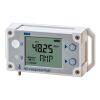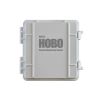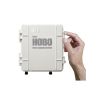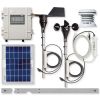HOBO Differential Air Pressure Transducer
Features
- Available in three installation configurations
- Field-selectable sub-ranges
- Sensor has IP65/NEMA 4 rating
- Expedited repair and warranty service
- Lifetime technical support
- More
Overview
The Onset differential air pressure transducer sensor measures either air pressure or velocity with the flip of a switch. Available in three installation configurations (duct, panel, or universal). Duct and panel models have two pressure and velocity range options: 0-1" WC / 0-3,000 ft/min or 0-10" WC / 0-7,000 ft/min, with seven field-selectable sub-ranges for pressure and eight for velocity. All variants are available with and without display. This sensor has an IP65/NEMA 4 environmental rating.
Requirements (Logger Specific):
- HOBO MX1100 series: a 0-5 Volt DC input cable (SD-VOLT-05) and external power provided by an AC adapter (AC-SENS-1)
- HOBO U12, UX120-006M, or ZW series: a 0-5 Volt DC input cable (CABLE-ADAP5) and external power provided by an AC adapter (AC-SENS-1)
- HOBO RX3000: an analog input module (RXMOD-A1)
- HOBO U30: an analog input module (VIA)
- HOBO H22: an analog input module (S-FS-CVIA)
- Media Compatibility: Dry air or inert gas
- Input Power: 12-30VDC, or 24VAC nominal
- Output Field-selectable: 2-wire, loop-powered 4-20mA (DC only, clipped and capped) or 3-wire 0-5V/0-10V
- Pressure Ranges: Unidirectional: 0.1/0.25/0.5/1.0” W.C. F.S. (25 pa/50 pa/100 pa/250 pa, F.S.), switch electable; Bidirectional: ±0.1/±0.25/±0.5/±1.0” W.C. F.S. (±25 pa/±50 pa/±100 pa/±250 pa, F.S.), switch selectable
- Response Time: Standard: T95 in 20 sec, Fast: T95 in 2 sec, switch selectable
- Mode: Unidirectional or bidirectional, switch selectable
- Display: (option) Signed 3-1/2 digit LCD, indicates pressure, overrange indicator
- Proof Pressure: 3 psid (20.6kPa)
- Burst Pressure: 5 psid (34.5kPa)
- Accuracy: ±1% F.S. of selected range (combined linearity and hysteresis)
- Temperature Effect: 1" 0.05%/°C; 10"
- Zero Drift: (1-year) 1" 2.0% max.
- Zero Adjust: Pushbutton auto-zero and digital input (2-pos terminal block)
- Operating Environment: 0°- 60°C (32° to 140°F); 0 to 90% RH non-condensing
- Fittings: Brass barb; 0.24” (6.1mm) o.d.
- Physical: UL 94 V-O Fire Retardant ABS
In The News
From Paddles to Phytoplankton: Studying Vermont’s Wildest Lakes
For six months of the year, Rachel Cray, a third-year PhD student at the Vermont Limnology Laboratory at the University of Vermont, lives between a microscope and her laptop, running data. For the other six months, she is hiking and canoeing four of Vermont’s lakes, collecting bi-weekly water samples. Cray studies algal phenology across four lakes in Vermont, US, that have low anthropogenic stress—or in other words, are very remote. Funded by the National Science Foundation Career Award to Dr. Mindy Morales, the lakes Cray researches part of the Vermont Sentinel Lakes Program, which studies 13 lakes in the area and, in turn, feeds into the Regional Monitoring Network, which operates in the Northeast and Midwest US.
Read MoreReimagining Water Filtration: How Monitoring and Science Enhance FloWater Filtration Systems
Over 50% of Americans think their tap water is unsafe , according to the Environmental Working Group (EWG). Other recent surveys have found that number to be as high as 70% of persons surveyed. Whether due to increased public awareness of water quality issues or confusion about how municipal water sources are regulated, there is a clear distrust of tap water in the United States. According to industry expert Rich Razgaitis, CEO and co-founder of the water purification company FloWater, this issue creates a damaging cycle. Razgaitis explained that the health and environmental problems associated with contaminated water aren’t the only issues. As people become increasingly aware that some tap water is unsafe, they resort to bottled water.
Read MoreMonitoring New Hampshire’s Aquatic Ecosystems: Continuous Data Collection in the Lamprey River Watershed
New Hampshire’s aquatic ecosystems provide a range of ecosystem services to the state and region. Resources and services like clean water, carbon storage, climate regulation, nutrient regulation, and opportunities for recreation all depend on New Hampshire’s aquatic ecosystems remaining healthy. Jody Potter, an analytical instrumentation scientist at the University of New Hampshire (UNH), is studying these aquatic ecosystems in hopes of developing an improved understanding of ecosystem services and their interactions with climate change, climate variability, and land use changes. [caption id="attachment_39799" align="alignnone" width="940"] Aquatic sensors in the Merrimack River in Bedford, NH, with I-293 in the background.
Read More










